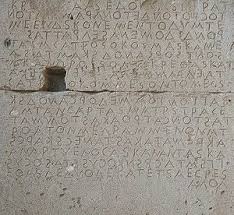
Punctuation is, today, an integral part of any written text. Words become almost nonsense without the presence of commas, full stops and question marks.
Yet thegreekswroteexactlythatway, yes, just like that, with a series of letters one after the other, with no regard for upper or lower case letters, spaces or other signs or symbols. And then, along came Aristophanes of Byzantium as the head librarian of the infamous Library of Alexandria. Tired of reading scroll after parchment scroll without taking a breath, he decided to introduce dots between segments of text to indicate when the reader should take a breath.
The romans, not quite convinced of the beauty of what we now term punctuation, wentbacktotheoldsystem. Readers then had to wait for the spread of Christianity to see the return of punctuation when Saint Isidore, the Archbishop of Seville, (strangely sainted for reasons other than his gift of reading comprehension) took up Aristophanes system of dots. Slowly, ever so slowly, new elements such as the question mark, the slash and the dash were introduced.
By the 15th century, thanks to the advent of the printing press which standardized text, punctuation: a mix of dots, dashes, commas, and question marks, stood frozen in time in a sort of hibernation. Now, in the digital age, punctuation, FWIW, is rather waking up, or even disappearing, being manipulated for <3, and emoticons and emojis are our new forms :O Who knows what the next 2000 years will bring.
Reference:
http://www.bbc.com/culture/story/20150902-the-mysterious-origins-of-punctuation
maka language consulting
www.makaitalia.com


